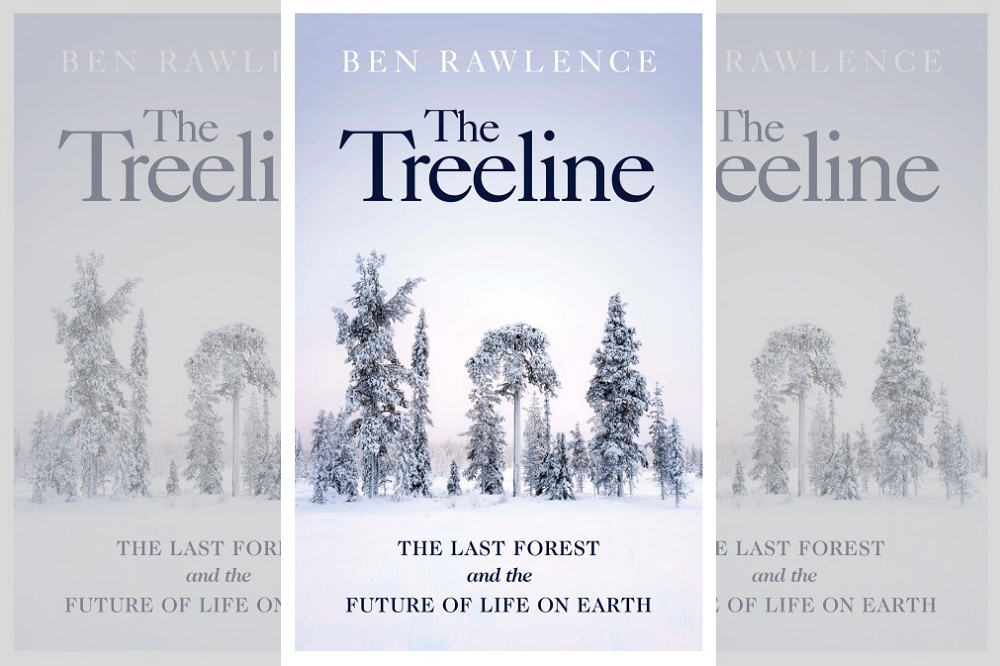Review: The Treeline by Ben Rawlence

Jon Gower
Forests are viewed in so many ways – as places of enchantment or fairy tale darkness, reservoirs of biodiversity and even basic timber supplies. Think of the word “forest” and our minds perhaps turn to Amazonia, to that enormous rain forest currently being cleared and burned at a terrible lick. But this book reminds us about another great expanse, the boreal forests which ring the northern rim of the world and collectively make up ‘the true lung of the world.’
Writer and founder of Wales’ inspirational Black Mountains College Ben Rawlence tells the story of species that have adapted to the cold over a long, long time, from Scots Pine and Downy Birch through Dahurian larch and Black and White Spruce to Balsam poplar and Greenland mountain ash.
He visits their often-challenging habitats, always doing so with a sense of wonder. He sees them as ‘refugees from another era with a life cycle so much longer than human timescales.’ Little wonder then that the Celts thought species such as yew to be sacred, able, as it is, to regenerate itself forever.
Ben Rawlence travels from the shadow of the yew tree near his home in Llanelieu, Powys to see other remarkable specimens, along the way charting the changes being wrought by human action, and sometimes inaction in places such as Scandinavia, Alaska, Scotland, Siberia, Canada and Greenland.
In so doing he presents us with a compelling blend of travel writing, clear-eyed, sober, scientific reportage and plentiful ecological insight.
Reaching some of these places is far from easy. He has to swim to the forested islands in Loch Maree, Scotland while some of his journeying across Siberia make the hardships of the great travel writer Colin Thubron seem like holidays, not least a trundling long-distance trip across a frozen land when Rawlence is denied any sleep.
Starkly beautiful
He spends time with reindeer herders, despondent glaciologists, genuine visionaries and intuitive native peoples such as the Sámi and Nganasan who are intimately in tune with the world around them.
They hold out clues for future living, showing how to respect the world, to live with nature and appreciate its myriad complexities. Learning how to ‘look and see with ancient eyes,’ Rawlence suggests, might help in a world that’s rapidly cooking up, sending the treelines – not, in truth lines but rather transition zones between ecosystems – northward at an unnatural speed.
What is the result? The steppes of Central Asia replace the burned- out taiga of Russia while the Arctic tundra changes colour and releases huge amounts of gas into the atmosphere.
Meanwhile, in Siberia record temperatures collapse the permafrost, bringing down buildings and causing the snow to melt so early that the Siberian Times notes how ‘not a snowflake left on the tundra and white hares hopping around on green ground looking bewildered.’
Some of the writing in The Treeline is starkly beautiful, such as this account of a morning in Siberia:
“Beyond the sparse buildings of the science station, where blonde Kolya is examining claw marks on a smashed-in door, apparently the work of a wolverine, the trees grow stunted, thin out, and stop amid knee-deep snow. I stare away from the rising sun out towards the tundra emerging from the dawn, the beautiful, unforgettable, crisp edge of the forested world. It is an abrupt treeline. In the long dawn shadows the trees appear as arrested figures wandering in clumps of two and threes…”
There’s a great deal of such vivid evocation. The air is ‘so clean and crisp it could cut paper.’ The scent of a meadow is ‘so heady it should be bottled.’ The surface of a fjord ‘wears a mist resembling fur that is the colour of dirty milk.’
But there are many stone-cold statistics, too. One seventh of Canada’s boreal forests have been clear-cut since 1990, much of it to make pulp for toilet paper. Siberia’s rivers are discharging 15 per cent more water into the ocean than a decade ago. In 2019 the Greenland ice sheet lost 245 billion tonnes of ice.
Labyrinthine connections
In Welsh there’s a saying ‘dod a dyn at ei goed’ which means to come to one’s proper senses, to realize one’s faults or follies, and they can seem like watchwords for Rawlence’s book.
The Treeline is wise and considered, offering both klaxon warning about the state of the earth and beautiful hymn to its interdependencies. He treads the fine line between being a doom-monger and attentive celebrant of the world’s, well, astonishingness.
Astonishing as the fact that trees can sterilize the air with their antiseptic properties or communicate with each other via tiny aerosol sprays or through the marvellous, labyrinthine connections of their root networks.
Or, even more extraordinary, how trees provide nutrients necessary for photo plankton, the base of the ocean food web, so that clear felling on can lead to a famine in the sea.
Thus, science is only just beginning to fathom the puzzling truth planted in the Japanese proverb ‘If you want to catch a fish, plant a tree.’
There are old, old wisdoms on this earth we would be very wise to heed. Or, as Rawlence tellingly points out, despair is the first step towards repair.
The Treeline: The Last Forest on Earth and the Future of Life on Earth is published by Jonathan Cape and is available from all good bookshops.
Support our Nation today
For the price of a cup of coffee a month you can help us create an independent, not-for-profit, national news service for the people of Wales, by the people of Wales.




